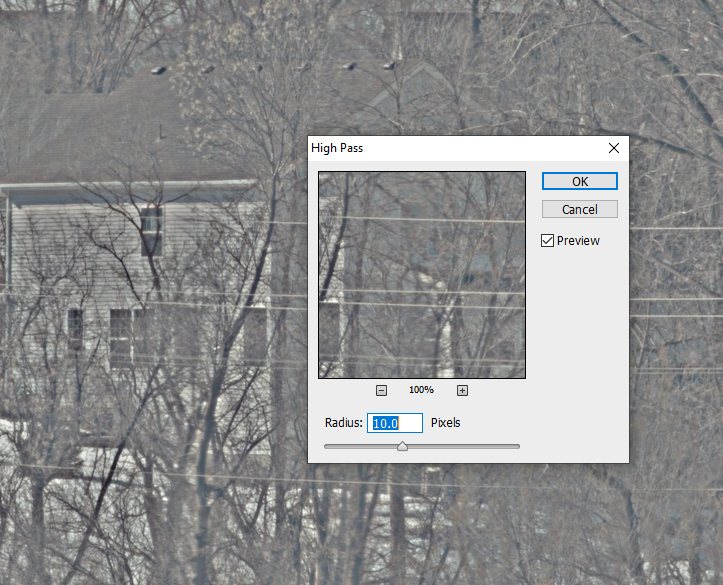- Home
- Premiere Pro
- Discussions
- Re: Is there a high-pass filter for videos in Adob...
- Re: Is there a high-pass filter for videos in Adob...
Copy link to clipboard
Copied
What I want to do is putting in high-pass filter effect on each image constituting a video by using Adobe Premiere Pro 13.1.2.
Premiere Pro has a high-pass filter for audios but it does not have a high-pass filter for videos as far as I can see. Photoshop does.
Any idea?
Thanks in advance.
 1 Correct answer
1 Correct answer
I found this.
Unsharp Mask is BOTH a high- and low-pass filter.
So you:
- Make a low-pass filter (radius parameter) - Gaussian blur - result in a low-frequency image
- subtract this from original image which results in a high-pass image this is the unsharp mask
- Make a ramped contrast image of original (increased contrast is a sort of high-pass operation)
- Compare luminosity of the above two images (mask vs contrasty): 100%? then use contrasty pixel; 0% use original pixel; 0 < luminosity < 100 ? blend
To sum
...Copy link to clipboard
Copied
I think you might be talking about adjustments in Lumetri that can be made, and 'Looks' that can be applied quickly...
Change the look of your clips |
???
Copy link to clipboard
Copied
No, the "Lumetri Color" does not have a high-pass filter effect.
Copy link to clipboard
Copied
I have no idea what sort of effect you want. And understand there is a MASSIVE difference between stills effects and video post-processing effects. So a bit more explanation would be useful.
Stills work on one image. Video post effects have to work real-time on 24-60 images per second.
Neil
Copy link to clipboard
Copied
Basically, I want to use a filter like the "High Pass" filter on Photoshop to each frame of a video. Each frame of my video contains scientific data, which were exported by a sort of detector, and want to extract meaningful data out of the noise.
Firstly, I thought it can be done with Fourier transformation but it is a little hassle to implement. If it is possible to take a high pass filter on Premiere Pro, it is very simple.
Copy link to clipboard
Copied
And Chris did a good start on the info for you. I've a 40+ year career as a professional portrait photographer including 20+ years of running our own full color lab, many years of digital images.
Spaced totally on the high/low frequency method of sharpening.
AfterEffects may also have a usable set of tools for this.
Neil
Copy link to clipboard
Copied
I also have AfterEffects, so the way to use AfterEffects is also welcome.
Copy link to clipboard
Copied
if you really need it, you can set all your tools to smart layers in photoshop and do some work in there. it's only meant for simple things and isn't an NLE but CMYK control with video, what the!?!?!? hehe...
btw, premiere has an unsharp effect which is a similar cousin as well. I'll keep an eye out for 3rd party plugins and let you know if I see any.
Copy link to clipboard
Copied
I found this.
Unsharp Mask is BOTH a high- and low-pass filter.
So you:
- Make a low-pass filter (radius parameter) - Gaussian blur - result in a low-frequency image
- subtract this from original image which results in a high-pass image this is the unsharp mask
- Make a ramped contrast image of original (increased contrast is a sort of high-pass operation)
- Compare luminosity of the above two images (mask vs contrasty): 100%? then use contrasty pixel; 0% use original pixel; 0 < luminosity < 100 ? blend
To sum up: the sharpening is a high-pass operation blended with the original using a weighting process influenced by a low-pass filter.
Copy link to clipboard
Copied
Thank you for your information.
Please let me confirm your suggestion:
Bring each frame of the video into Photoshop and process them with Low pass filter and so on?
No way to complete on Premiere Pro?
Copy link to clipboard
Copied
do you always use the same radius setting for your photoshop filter ??? like this ???

Copy link to clipboard
Copied
also, is your video a bunch of numbered individual frames imported as a sequence or is it a regular video ( like mp4 or whatever).
??
Copy link to clipboard
Copied
Yes, I use the same radius setting for each frame of the video.
My video is mp4 format, which is created by a kind of experiment device. If it were a sequence, maybe I could use Photoshop's filter for the individual frames.
Copy link to clipboard
Copied
Yes, that was one idea... use photoshop and do a batch process of a macro using high pass on all images (sequence ). I suppose you could do that if you export the mp4 as numbered images, go to psd and do stuff, and then put BACK into PPro as a sequence.
Never tried it. Could do a small test to see if it works maybe.
Other idea was to use a different NLE (node based ) and see if a simple way was available. I tried it ( basically made a grade from the sample high pass I did on an image, and tried to apply it to the same image ( normal color ).. and it didn't work. I'll probably get back into it on my own just to learn how to do it ( found instructions similar (to some extent) to what Chris posted using parallel nodes and a blending node on internet ). I like learning from posts here.
![]()
Find more inspiration, events, and resources on the new Adobe Community
Explore Now